Adopting Zero Trust
Adopting Zero Trust offers an ongoing conversation that elevates cybersecurity conversations that encourages you to rethink how you build strategies, defend against threat actors, and implement new technology. We go beyond the millions in marketing budgets fueled by VCs, and chat with practitioners like you who want to make a difference (or hack the planet, which ever happens first).
Episodes
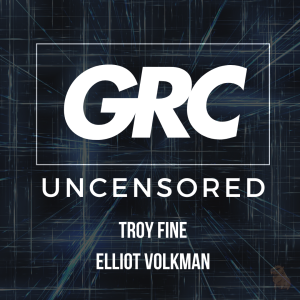
Thursday Oct 10, 2024
Thursday Oct 10, 2024
We are interrupting our regularly scheduled podcast series to introduce you to a new series we developed: GRC Uncensored.
This pilot season will elevate conversations about GRC that are often buried under millions of dollars in marketing spend. No boring talks about controls or frameworks, just unfiltered discussions with auditors and practitioners in the GRC space. We'll be back to our regular AZT episodes in a couple of weeks.
-----
In the first episode of 'GRC Uncensored,' hosts Troy Fine, dubbed the 'GRC Meme King,' and Elliot Volkman, alongside guest Kendra Cooley dive into the complexities of Governance, Risk, and Compliance (GRC) in cybersecurity. The discussion unravels the 'love-hate' relationship many security professionals have with compliance frameworks like SOC 2, exploring how they have become commoditized and possibly devalued over time.
The conversation touches upon the challenges security practitioners face in conveying the true value of GRC to businesses, the potential pitfalls of 'SOC in a box' offerings, and the broader implications of compliance becoming a 'check the box' exercise. Moreover, the episode delves into the broader regulatory landscape and the ongoing debates about the role of government regulations in cybersecurity compliance. This candid dialogue sets the stage for future episodes that promise further to dissect the nuances of cybersecurity audits and standards.
00:00 Welcome to GRC Uncensored
01:34 Introducing Kendra Cooley
02:05 Love-Hate Relationship with GRC
03:16 The SOC 2 Debate
04:33 Challenges with SOC 2 Audits
09:10 The Value of SOC 2 in the Industry
12:04 The Evolution of Compliance Frameworks
20:39 False Sense of Security in Compliance
24:46 The Buzz Around AI and Quantum
25:10 Staying Updated as a Security Professional
26:45 Challenges in Penetration Testing and Vendor Assessments
27:37 Compliance and Its Impact on Security
30:10 Government Regulations and Their Effectiveness
32:23 The Complexity of Privacy Laws
38:29 The Role of GRC Teams in Risk Management
42:30 Concluding Thoughts and Future Episodes
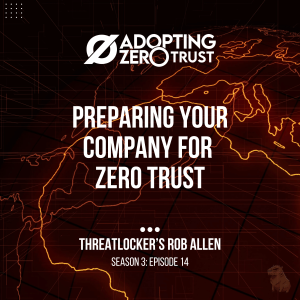
Thursday Sep 26, 2024
Thursday Sep 26, 2024
Welcome back to Adopting Zero Trust! In this episode, hosts Elliot Volkman and Neal Dennis are joined by Rob Allen, Chief Product Officer of ThreatLocker, to dive deep into the operationalization of Zero Trust. Despite covering various aspects over three seasons, this crucial topic is addressed thoroughly.
They explore pre-adoption preparation, aligning organizational actions, and the importance of education in security. Additionally, the conversation highlights the 'assume breach' perspective and how concepts like default deny and least privilege are essential. With real-world examples and anecdotes, they provide actionable insights on implementing Zero Trust strategies effectively. Tune in to learn about the foundational steps necessary to transition into a Zero Trust environment.
This is the first of a three-part mini-series, so stay tuned as we explore more aspects of how to prepare your organization for adopting a Zero Trust strategy.
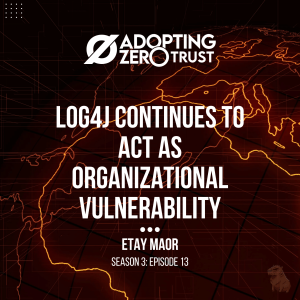
Thursday Sep 05, 2024
Thursday Sep 05, 2024
Season 3, Episode 13: Cato Network’s Etay Maor provides fresh research on the abuse of unpatched log4j libraries.
Catch this episode on YouTube, Apple, Spotify, or Amazon. You can read the show notes here.
This week on Adopting Zero Trust (AZT), we highlight a significant cybersecurity risk focused on the notorious Log4j vulnerability and the growing concern around shadow IT. Featuring expert insights from Etay Maor, the Chief Cybersecurity Strategist at Cato Networks, the conversation initially looks into the persistent exploitation methods, the importance of knowing one’s cybersecurity environment, and strategic approaches to mitigating risks.

Tuesday Aug 20, 2024
Tuesday Aug 20, 2024
Season 3, Episode 12: Could the overturning of Chevron Deference impact cybersecurity and privacy regulations?
Catch this episode on YouTube, Apple, Spotify, or Amazon. You can read the show notes here.
Welcome back to Adopting Zero Trust or AZT. In our latest episode, we assembled a distinguished panel to dig into a timely topic affecting the cybersecurity landscape but has the fog of war wrapped around it. Today’s conversation centered around the recent developments in cybersecurity regulations and their potential impacts, ignited by the Supreme Court overturning Chevron Deference. This, of course, has other potential impacts on all regulation types enforced and shaped by federal agencies, but our focus is, of course, on cybersecurity, privacy, and AI.
The Panel
We welcome back Ilona Cohen, Chief Legal and Policy Officer at HackerOne, who joined us last year to discuss the National Cybersecurity Strategy. Ilona is also the former General Counsel for OMB. We are also joined by the GRC meme king, Troy Fine, the Director of SOC and ISO Assurance Services at Gills Norton. Beyond the memes, Troy takes a practical perspective on regulations and acts as our voice for those who may be most immediately impacted.
Key Takeaways
Chevron Deference overturned: The Supreme Court's decision removes the requirement for courts to defer to federal agencies' interpretations of ambiguous statutes and now relies on the courts.
Increased regulatory uncertainty: This ruling may lead to more challenges to existing and future regulations, potentially affecting cybersecurity and AI policies.
State vs. Federal regulation: The uncertainty at the federal level might prompt states to act more quickly on issues like AI and cybersecurity, potentially creating a patchwork of regulations.
Impact on AI regulation: With about 40 federal bills addressing AI in the pipeline, the ruling could complicate the process of creating comprehensive federal AI regulations.
Cybersecurity implications: Existing and proposed cybersecurity regulations, such as the Cyber Incident Reporting for Critical Infrastructure Act, may face new challenges.
Business concerns: While some business organizations applauded the ruling, the resulting regulatory uncertainty could be problematic for companies trying to plan and comply with regulations.
Expertise concerns: There are worries that courts may lack the technical expertise to make decisions on complex technological issues like AI without deferring to agency experts.
Potential for innovation: The regulatory uncertainty might create a wild west period for AI, potentially fostering innovation before more stringent regulations are imposed.
Self-regulation importance: In the absence of clear federal regulations, industry self-regulation initiatives may become more significant, especially in rapidly evolving fields like AI.
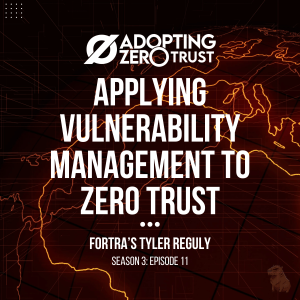
Thursday Aug 01, 2024
Thursday Aug 01, 2024
Season 3, Episode 11: Vulnerability management is critical to any Zero Trust strategy, but you probably already know that. Fortra’s Tyler Reguly breaks down severity vs. risk.
Catch this episode on YouTube, Apple, Spotify, or Amazon. You can read the show notes here.
Every organization relies on some form of technology to run, and each tool you add increases the risk of vulnerabilities causing problems. If you don’t stay on top of patching, you increase the odds of a bad actor finding their way more easily within your network.
This week, we chat with Tyler Reguly, a senior manager of security research at Fortra, who shares insights from his 18 years in vulnerability management. Tyler discusses the importance of staying on top of patching to maintain a Zero Trust strategy, the differences between vulnerability and patch management, and emphasizes that the Common Vulnerability Scoring System (CVSS) measures severity, not risk.
We also briefly nerd out about the significance of groups like the Canadian Cyber Threat Exchange (CCTX) for knowledge sharing and collaboration in cybersecurity. And then, we wrap things up by exploring the efficacy of existing security policies and benchmarks, such as CIS and DISA STIGs, and the role of vendor relationships in maintaining effective security practices.

Tuesday Jul 02, 2024
Tuesday Jul 02, 2024
Season 3, Episode 10: Elliot chat’s with Vivek Ramachandran of SquareX about his approach to tackling the impossible: Social engineering.
Catch this episode on YouTube, Apple, Spotify, Amazon, or Google. You can read the show notes here.
For nearly three decades, social engineering, particularly phishing, has been one of the most impactful and financially draining cyber threats. Between security awareness training, email security gateways, generative AI, enterprise browsers, and a slew of other tech like EDRs and XDRs, social engineering has yet to be thoroughly thwarted. The reason for that is straightforward enough: social engineering is a psychological threat, not just a technological one.
In our last round of interviews from RSA, we chatted with Vivek Ramachandran, the founder of SquareX, who is attempting to tackle the challenge. Vivek also walks us through a more realistic perspective of how threat actors use generative AI today, which goes beyond the more unique what-if scenarios we’ve seen in headlines in the past two years.
Key Takeaways
Social engineering and phishing attacks remain a significant threat, and everyone can be a target. The sophistication of these attacks has increased due to advances in AI.
AI can craft messages that sound remarkably like someone the recipient knows, enabling rapid scalability.
Social media platforms are becoming common channels for launching phishing attacks. Attackers exploit the trust that users place in these platforms and their contacts.
Vivek Ramachandran's company, SquareX, deploys a browser extension that can attribute attacks and detect and block them in real-time, providing valuable information to the enterprise.
Traditional technologies like Secure Web Gateways (SWG) have matured, and attackers can easily bypass them.
Enterprise browsers solve the problem for a small niche group of websites but have adoption friction due to the inconvenience of having a dedicated browser.
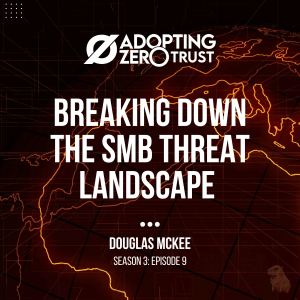
Thursday Jun 13, 2024
Thursday Jun 13, 2024
Season 3, Episode 9: We chat with SonicWall’s Doug McKee about the top 5 threats targeting SMBs based on recent research.
Catch this episode on YouTube, Apple, Spotify, Amazon, or Google. You can read the show notes here.
Cybersecurity challenges come in many different flavors regardless of how old your company is or how many employees it houses. Larger companies have to deal with layers upon layers of technology, processes, and the people who support it. Smaller organizations are resource-constrained, often lack the experience or expertise to build a proper program, and typically rely on external support systems.
While larger companies may not be nimble, typically, they employ and understand the value of threat intelligence to hone in on risks that could impact the business. They also have larger targets on their back because they are seen as more valuable targets for data, financial drain, and other nefarious purposes. In the same, smaller organizations may not be as valuable as a direct target, but they can be seen as a doorway into these larger companies. It’s for these reasons that supply chain attacks, even older ones, are among the top threats targeting small businesses and startups.
This week on AZT, we examine the top five threats targeting startups and small businesses and chat with SonicWall’s Executive Director of Threat Research about the WHY behind them. As a researcher and educator through SANS, Doug McKee shares his perspective on why smaller shops need to consider threat intelligence as part of their cybersecurity program and how MSPs can help fulfill that capability.
Top 5 threats to SMBs (According to SonicWall)
Log4j (2021) more than 43% of organizations were under attack
Fortinet SSL VPN CVE-2018-13379 - 35% of orgs were under attack
Heartbleed (2012) - 35% of organizations
Atlassian CVE-2021- 26085 - 32 %
Vmware CVE-2021 - 21975 - 28% of orgs
The Guest: Douglas McKee
Doug is an experienced information security professional who possesses extensive technical expertise acquired through involvement in application and system security testing, hardware and software vulnerability research, malware analysis, forensics, penetration testing, red team exercises, protocol analysis, application development, and risk mitigation activities. These technical proficiencies are complemented by adept leadership and communication skills, honed through the leadership of teams and projects, collaboration within both large and small teams, and the composition of technical reports for clients.
Doug is recognized for discovering numerous CVEs and regularly speaks at prominent security conferences such as Blackhat, DEFCON, RSA, Hardware.io, and Ekoparty. Additionally, Douglas's research is frequently featured in publications with a wide readership, including Wired, Politico, Bleeping Computer, Security Boulevard, Venture Beat, CSO, Politico Morning eHealth, Tech Republic, and Axios.
Key Takeaways
None of these vulnerabilities in SonicWall’s research were found or disclosed between 2022-2024, and yet we’re still dealing with them
Old vulnerabilities remain a significant threat
The most widespread attacks for SMBs include Heartbleed and Log4j vulnerabilities
Many widespread vulnerabilities are supply chain vulnerabilities
These vulnerabilities are embedded in multiple products and systems
Patching vulnerabilities can be complex and costly
Compliance and regulatory standards can complicate the process
Attackers are becoming increasingly nuanced in their approaches

Thursday Jun 06, 2024
Thursday Jun 06, 2024
Season 3, Episode 8: AZT and Dr. Zero Trust have a crossover episode where we chat with reps from MITRE and OWASP about challenges associated with emerging threats.
Catch this episode on YouTube, Apple, Spotify, Amazon, or Google. You can read the show notes here.
Every few weeks, and occasionally every few days, we hear report of a new novel technique or zero day. Those headlines often create an unnecessary level of fear for organizations, but battle-worn cybersecurity professionals know just because it’s on a headline doesn’t necessarily mean it will impact their environment. That is because emerging threats are just that, new and novel. While zero day threats can be interesting and something to be aware of, most threat actors stick to tried and true methods.
But how do we identify what is most impactful to our security posture, attack surface, or insert your other buzzy term? Threat intelligence and the collective defense. And for that, it’s time to introduce our two very equipped guests to navigate this conversation and our guest moderator:
This week on AZT, we have representatives from OWASP and MITRE, with Dr Zero Trust leading the charge.
The Guests
Special Guest Moderator
Dr. Chase Cunningham - Dr. Zero Trust and Vice President of Security Market Research for G2
Avi Douglen - Chair of the Global Board of Directors for the OWASP Foundation and Founder and CEO of Bounce Security.
Avi is a security architect and software developer, leading development teams in building secure products for over 20 years. As a systems developer and security consultant, over the years Avi has amassed much technical knowledge and understanding of the enterprise security needs at the business level. Avi currently serves on the OWASP Global Board of Directors, and leads the Israel chapter. He is the founder and leader of the the popular AppSecIL security conference, the OWASP Threat Modeling Project, and co-authored the Threat Modeling Manifesto. He is a community moderator on Security StackExchange, and a frequent speaker at industry conferences, recent ones can be seen here.
Stanley Barr - Senior Principcal Cyber Researcher for MITRE
Dr. Stanley Barr is a three time graduate of University of Massachusetts Lowell. He has a BS in Information Sciences, an MS in Mathematics, and a PhD in Computer Science. He has coauthored published papers in malware analysis, barrier coverage problems, expert systems for network security, and robotic manufacturing. He has spoken at MILCOM, RSA, Bsides Boston, and Defcon. He has been a panelist for conferences. Panels topics have included fighting through real world computer network attacks from both external and internal threats. Currently, he is a Senior Principal Scientist at The MITRE Corporation, a not-for-profit corporation that manages six federally funded research and development centers (FFRDCs).
Key Takeaways
Emerging threats are interesting, but threat modeling and understanding how systems work to identify potential issues is more impactful
AI can pose a threat due to its ability to remember and tailor information, as well as its scalability.
The panel emphasized that basic security hygiene is often overlooked, such as enabling 2FA on all accounts.
The OWASP Top 10 most common attack vectors are still a significant concern, but they should not be the only focus.
The panel argued that responsibility for security breaches should extend beyond the CISO to the entire board and engineering organization.
Cybersecurity is a people-centric challenge, and relying on people not to make mistakes is not a sustainable strategy.
There is value in investing in proper security measures, as it can save organizations money in the long run.
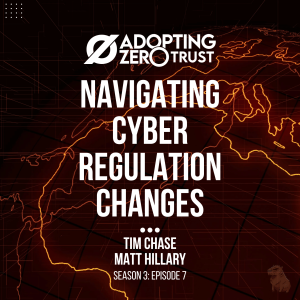
Thursday May 30, 2024
Thursday May 30, 2024
Season 3, Episode 7: Though regulation impacting cybersecurity moves slow, when new laws are introduced it often puts significant strain on companies. Lacework’s Tim Chase and Drata’s Matt HIllary discuss navigating the latest broad-sweeping regulations.
Catch this episode on YouTube, Apple, Spotify, Amazon, or Google. You can read the show notes here.
The time between a law being proposed and going into effect may feel like a snails pace, but for cybersecurity and GRC professionals, it may feel like the DNA of an organization may need to change. This week we chat with cybersecurity leaders Tim Chase from Laceworks and Matt Hillary of Drata who delve deep into the ever-evolving landscape of cybersecurity regulations. They explore topics such as the challenges of rapid incident reporting, the role of collaboration in the industry, and the emerging onslaught of AI-related laws and proposed bills.
This Week’s Guests
Tim Chase, Lacework’s Global Field CISO
With over 15 years of experience in the cybersecurity industry, Tim is a Global Field CISO at Lacework, a leading cloud security platform. Tim holds CCSK, CISSP, and GCCC certifications and has a deep understanding of product security, DevSecOps, application security, and the current and emerging threats in the cybersecurity landscape.
Matt Hillary, Drata’s CISO
Matt Hillary currently serves as VP, Security and Chief Information Security Officer at Drata. With more than 15 years of security experience, Matt has a track record of building exceptional security programs. He most recently served as SVP, Systems and Security and CISO at Lumio, and he’s also held CISO and lead security roles at Weave and Workfront, Instructure, Adobe, MX, and Amazon Web Services. He is also a closet raver. Like really, actually is.
TL;DR
The landscape of cybersecurity regulations is ever-changing, with new bills and regulations continually emerging which impact businesses of various sizes.
The recent rules released by the SEC regarding the time frame for announcing a breach or incident have significantly impacted organizations. The term "material" is a key aspect of these rules, leading to discussions around what constitutes a material cybersecurity incident.
The role of a CISO is challenging due to the potential for breaches and incidents despite implementing comprehensive security measures. The additional regulations add further complexity to the role.
Transparency and honesty are vital in the event of a breach. Companies that are open about incidents and their impact are viewed more favorably than those that attempt to cover things up.
The concept of 'carrot and stick' in regulation is discussed. There are mixed feelings about this approach, with some preferring collaboration and industry-led standards over punitive measures such as fines. However, there is recognition that both incentives (the carrot) and punitive measures (the stick) can drive companies to improve their cybersecurity measures.
AI is a hot topic in the cybersecurity field, with potential to assist in quickly sorting through data and reducing false positives. However, the implementation of AI also brings its own set of regulations and challenges.

Tuesday Apr 30, 2024
Tuesday Apr 30, 2024
Season 3, Episode 6: Two seasoned cybersecurity professionals, Bryan Willett and Kris Lovejoy, shed light on the dilemma organizations face when hit by ransomware: Should they pay the ransom or not?
Catch this episode on YouTube, Apple, Spotify, Amazon, or Google. You can read the show notes here.
Ransomware: To Pay or Not to Pay? It’s an easy question, and we all have the same ideal answer, but how often does life throw us simplicity? Rarely.
This week on Adopting Zero Trust, we continue our conversation that looked at the role cyber insurance plays in organizations and drill into one of the most challenging topics associated with it: Ransomware. And, because this is a heavy subject, we brought in two heavy hitters from past episodes to share their perspectives, Kris Lovejoy and Brian Willett
TL;DR
Paying ransomware ransoms is a complex decision that depends on various factors, such as the potential impact on the organization's services or employees.
Having robust and tested backups is crucial in a ransomware situation, but organizations must be prepared for scenarios where ransomware affects backups.
Cyber insurance can help mitigate the financial impact of ransomware attacks, but organizations should be cautious and consider all the potential outcomes.
Avoiding ransomware attacks requires a proactive approach, which includes implementing hardening standards, good practices around vulnerability management, enforcing compliance on systems, and having good identity protection.
AI holds promise in the cybersecurity sector, but its role in ransomware attacks is still in its infancy.







